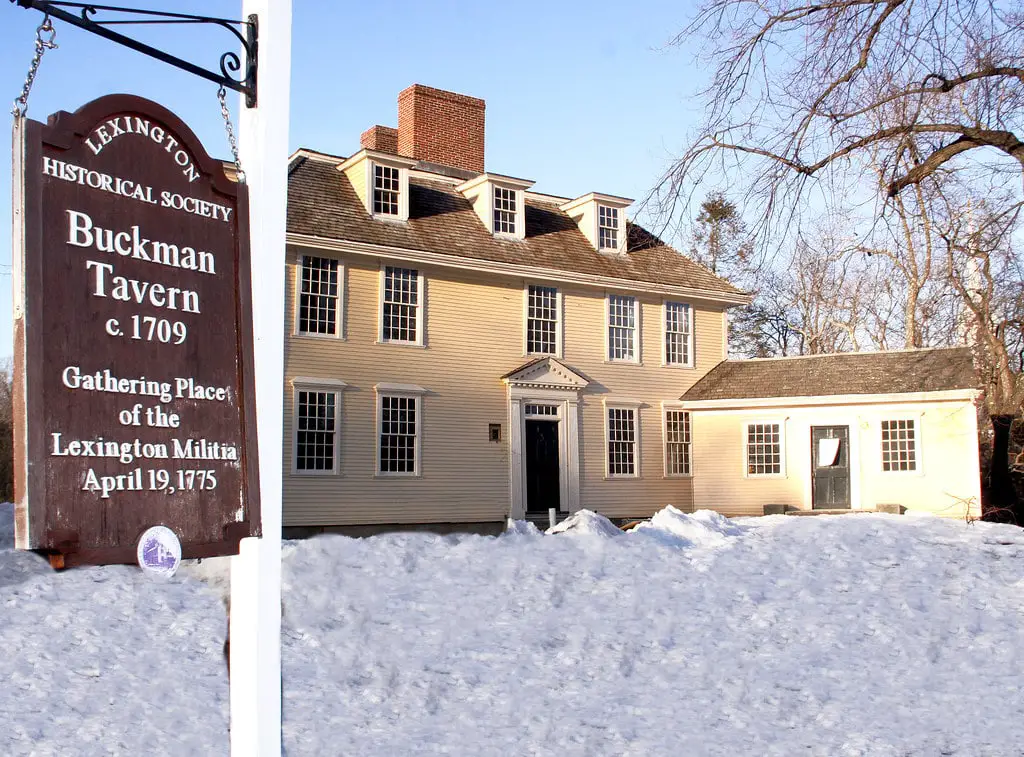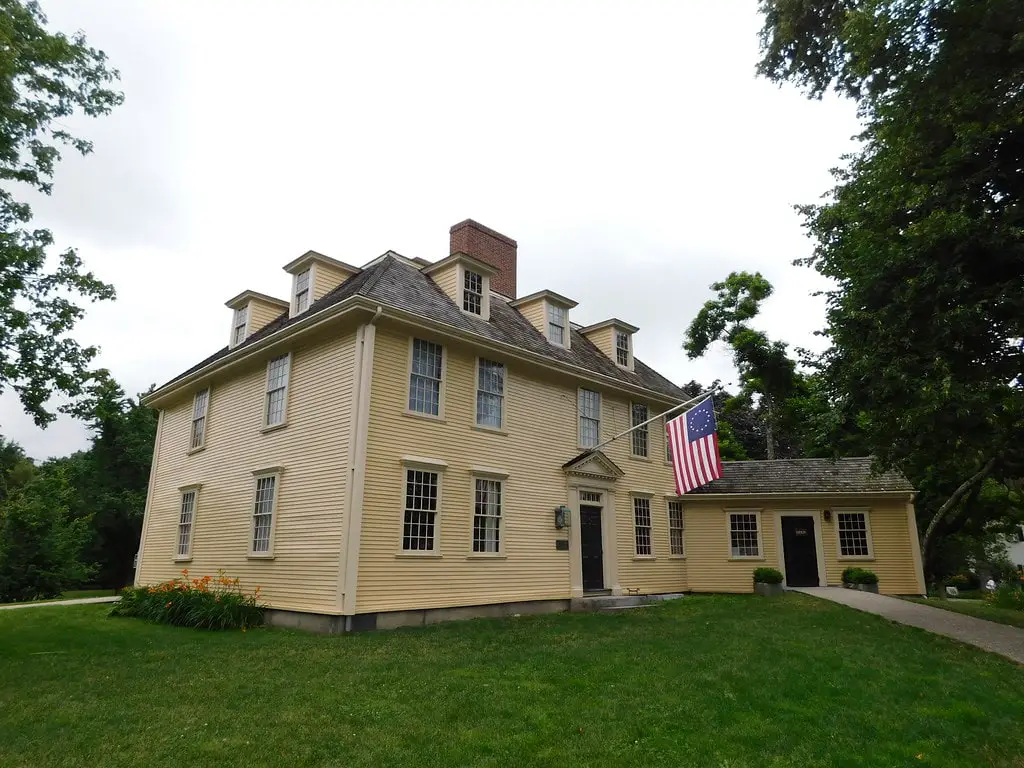The Historical Significance of Buckman Tavern
Buckman Tavern, a landmark steeped in American history, is a testament to the nation’s revolutionary past. Constructed around 1709-1710, this storied establishment was initially built by Benjamin Muzzey, a prominent figure in Lexington, Massachusetts.
The tavern quickly became a focal point in the community, serving as a social hub and a pivotal site for political and military discussions. Its walls, which have witnessed the ebb and flow of early American life, resonate with stories of the past.
As tensions between the American colonies and British rule escalated, Buckman Tavern was at the heart of revolutionary activities. On the morning of April 19, 1775, it served as the gathering place for Captain Parker’s militia.
These men, who were about to engage in the first battle of the American Revolutionary War, chose the tavern as their meeting point before confronting the British Redcoats.
This historic event marked the beginning of a conflict that would eventually lead to American independence. The tavern’s role in these pivotal moments has cemented its place in history.
Recognition and Preservation
Recognizing its significant contribution to American history, Buckman Tavern was designated a U.S. National Historic Landmark on January 20, 1961. This honor underscores the tavern’s importance as a symbol of American resilience and the fight for independence.
Further, on October 15, 1966, it was added to the National Register of Historic Places, ensuring its preservation for future generations. As of 2024, Buckman Tavern stands as a historical monument and bridge connecting the present to a past filled with courage and determination.
Buckman Tavern remains a must-visit destination for those interested in American history in the heart of Lexington, Massachusetts. It’s a key highlight in the list of things to do in Lexington, Massachusetts, offering visitors a chance to step back in time and experience the dawn of American independence.
Architectural Features and Restoration Efforts
Federal Architectural Style and Design
Buckman Tavern, an exemplar of the Federal architectural style, showcases the design sensibilities of the early 18th century. Crafted by Benjamin Muzzey, its architecture reflects the period’s preference for symmetry and simplicity.
With its well-proportioned facade and balanced design, the tavern’s structure offers a glimpse into the prevalent architectural trends in colonial America. Its enduring construction has allowed it to withstand the test of time, serving as a physical narrative of America’s architectural evolution.
Restoration and Preservation
Over the centuries, Buckman Tavern has undergone several restoration projects to preserve its historical integrity. These efforts ensure that the tavern maintains its appearance as it was in the 18th century, particularly during the 1775 Battle of Lexington and Concord.
Key features like the large fireplace and central chimney in the taproom have been carefully restored, providing visitors with an authentic experience of colonial tavern life. Preserving these historical elements is crucial in keeping the story of the American Revolution alive for future generations.
Historical Artifacts and Memorabilia
Among the most notable artifacts in Buckman Tavern is the old front door, marked by a bullet hole that is believed to have been made by a British musket ball during the battle. This poignant relic is a stark reminder of the conflict and sacrifice at Lexington.
The tavern also houses a collection of memorabilia and artifacts from the era, each telling its own story of the events and people who shaped American history.

Buckman Tavern as a Community Hub
A Gathering Place for Locals and Travelers
Throughout its history, Buckman Tavern has been more than just a building; it has been a central gathering place for the people of Lexington.
Serving locals and travelers, the tavern was a hub for social interaction, discussion, and community events. It played a significant role in the social fabric of Lexington, offering a space for people to come together, share news, and engage in the day’s issues.
Host to Important Town Meetings
Buckman Tavern’s significance was further amplified by its role in hosting important town meetings. These gatherings were crucial in shaping the political landscape of Lexington and, by extension, the emerging nation. The tavern’s walls have echoed with debates and decisions that contributed to the formation of American democratic principles and practices.
The First Village Store and Post Office
In 1813, Buckman Tavern expanded its role in the community by housing Lexington’s first village store and, later, the town’s first post office.
This transformation marked a shift in the tavern’s function from a purely social and political space to a commercial and civic center. Establishing these facilities within the tavern underscores its importance as a versatile and integral part of Lexington’s community life.
The Tavern’s Role in the Battle of Lexington and Concord
The Gathering of Militia on April 19, 1775
On the pivotal morning of April 19, 1775, Buckman Tavern witnessed a crucial moment in American history. It was here that Captain John Parker’s militia assembled in the early hours, bracing for the arrival of British troops.
This gathering at the tavern was a strategic move, providing a vantage point to monitor the Redcoats’ approach. The tense atmosphere within the tavern walls reflected the uncertainty and determination of the militiamen, who were about to partake in a battle that would ignite the Revolutionary War.
Strategic Location on the Battle Green
Buckman Tavern’s location adjacent to Lexington’s Battle Green was strategically important. It offered a direct view of the common where the initial confrontation between the American militia and British forces occurred.
This proximity to the Battle Green made the tavern a key military post and a witness to the first armed engagement of the Revolutionary War. The events that unfolded on the green and around the tavern marked the beginning of a long struggle for American independence.
The Mystery of the “First Shot”
One of the enduring mysteries of the American Revolution is the identity of the person who fired the first shot on the Lexington Battle Green, often referred to as the “shot heard ’round the world.”
This shot, which signaled the start of the conflict between the colonies and Britain, is shrouded in legend and lore. While it remains unclear who fired this first shot, the fact that it occurred near Buckman Tavern adds to the site’s historical significance.

Exhibitions and Educational Programs
Museum and Rotating Exhibitions
Today, Buckman Tavern is a historical landmark and a museum managed by the Lexington Historical Society. It hosts a variety of rotating exhibitions that delve into different aspects of the Revolutionary era.
These exhibitions provide visitors with an in-depth understanding of the period, highlighting the time’s societal, political, and military nuances. The tavern’s transformation into a museum allows for preserving and interpreting its rich history.
“Revolution in a Cup” Exhibition
A notable exhibition at Buckman Tavern is “Revolution in a Cup,” which explores the political symbolism of tea in revolutionary America.
This exhibition sheds light on events like the Boston Tea Party and the broader crisis surrounding the taxation and trade of tea. It features an array of tea wares from the Lexington Historical Society collection, offering a tangible connection to the past.
This exhibition is a testament to the tavern’s ongoing role in educating the public about the complexities of the American Revolution.
Educational Programs and Tours
In addition to exhibitions, Buckman Tavern offers a range of educational programs and tours. These initiatives are designed to engage different age groups, from school children to adults, providing an immersive experience of America’s revolutionary past.
The educational programs often include reenactments, interactive sessions, and guided tours, making history accessible and engaging for visitors. Through these efforts, Buckman Tavern continues to serve as a vital educational resource, fostering a deeper appreciation of American history.
The Helen Noyes Webster and Mary Milligan Memorial Herb Garden
Historical Significance of the Herb Garden
The Helen Noyes Webster and Mary Milligan Memorial Herb Garden, a significant feature of Buckman Tavern, offers a vivid glimpse into 18th-century horticulture. Originally planted in 1950, this garden is a space of botanical interest and a living piece of history.
It showcases a variety of herbs and plants that were commonly used during the colonial era, both for culinary and medicinal purposes. This garden is a tangible link to the everyday lives of those who frequented Buckman Tavern centuries ago.
Revitalization and Community Involvement
The herb garden underwent a significant revitalization, thanks to the dedicated efforts of longtime Historical Society members and volunteers, including Carla Fortmann, Elaine, and Guy Doran.
Their work, supported by the Lexington Field and Garden Club, has ensured that the garden remains a true representation of its original state. This collaborative effort highlights the community’s commitment to preserving and celebrating its historical heritage.
Educational and Cultural Value
Today, the herb garden is an attraction for visitors to Buckman Tavern and serves an educational purpose. It provides a unique opportunity for learning about colonial-era gardening practices and the use of herbs in daily life during that period. The garden enriches Lexington’s cultural and historical landscape, offering a serene and educational retreat for those interested in horticulture and history.

Recent Developments and Community Engagement
Updates and Enhancements at Buckman Tavern
In recent years, Buckman Tavern has seen several developments to enhance the visitor experience and preserve the site’s historical integrity.
These include updates to the museum’s exhibitions, restoration projects, and the introduction of new interactive elements. These efforts ensure that Buckman Tavern remains relevant and engaging for contemporary audiences while faithfully preserving its historical essence.
Buckman Tavern in Community Events
Buckman Tavern plays a pivotal role in Lexington’s community events, particularly those commemorating the American Revolution.
It is a focal point for historical reenactments, educational programs, and cultural gatherings. These events unite the community and attract visitors beyond Lexington, showcasing the tavern’s enduring appeal and significance.
Impact on Local Tourism and Visitor Experiences
Buckman Tavern is a key historical site significantly contributing to Lexington’s tourism sector. It offers a unique and immersive historical experience, drawing visitors interested in the Revolutionary War and American history.
The tavern’s rich narrative and well-preserved environment provide an educational and memorable experience, making it a must-visit destination. Through its ongoing operations and community involvement, Buckman Tavern plays a vital role in preserving history and contributing to the cultural richness of Lexington.
